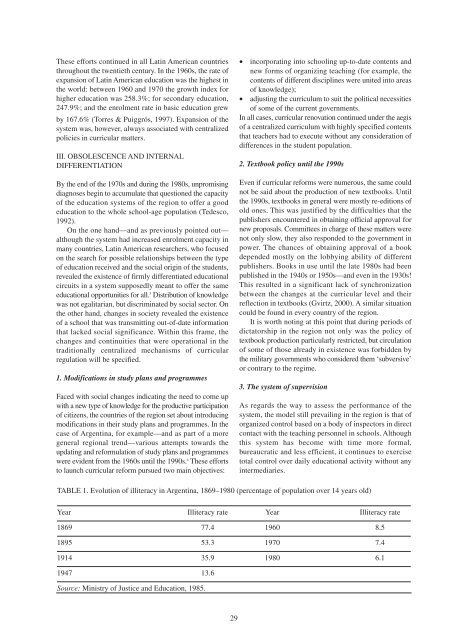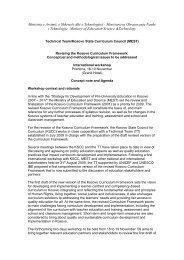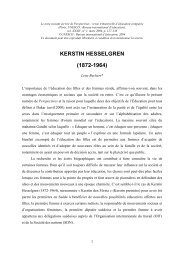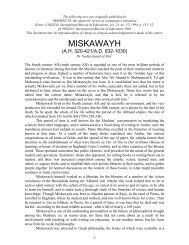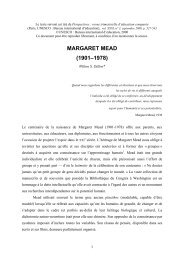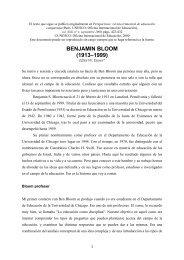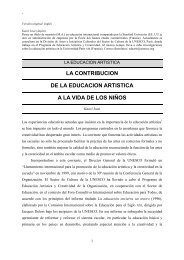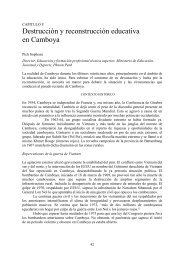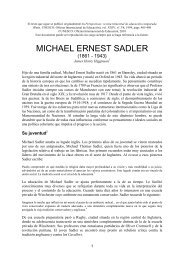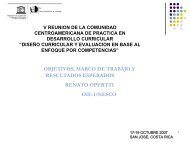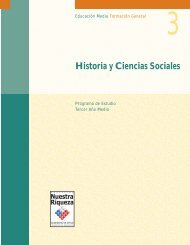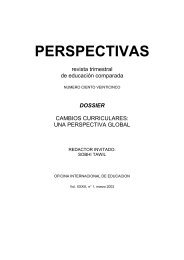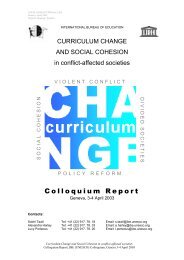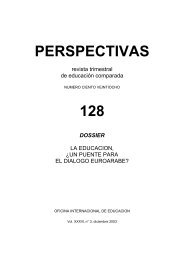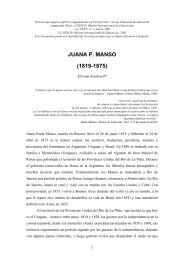Curriculum Change and Social Inclusion - International Bureau of ...
Curriculum Change and Social Inclusion - International Bureau of ...
Curriculum Change and Social Inclusion - International Bureau of ...
You also want an ePaper? Increase the reach of your titles
YUMPU automatically turns print PDFs into web optimized ePapers that Google loves.
These efforts continued in all Latin American countries<br />
throughout the twentieth century. In the 1960s, the rate <strong>of</strong><br />
expansion <strong>of</strong> Latin American education was the highest in<br />
the world: between 1960 <strong>and</strong> 1970 the growth index for<br />
higher education was 258.3%; for secondary education,<br />
247.9%; <strong>and</strong> the enrolment rate in basic education grew<br />
by 167.6% (Torres & Puiggrós, 1997). Expansion <strong>of</strong> the<br />
system was, however, always associated with centralized<br />
policies in curricular matters.<br />
III. OBSOLESCENCE AND INTERNAL<br />
DIFFERENTIATION<br />
By the end <strong>of</strong> the 1970s <strong>and</strong> during the 1980s, unpromising<br />
diagnoses begin to accumulate that questioned the capacity<br />
<strong>of</strong> the education systems <strong>of</strong> the region to <strong>of</strong>fer a good<br />
education to the whole school-age population (Tedesco,<br />
1992).<br />
On the one h<strong>and</strong>—<strong>and</strong> as previously pointed out—<br />
although the system had increased enrolment capacity in<br />
many countries, Latin American researchers, who focused<br />
on the search for possible relationships between the type<br />
<strong>of</strong> education received <strong>and</strong> the social origin <strong>of</strong> the students,<br />
revealed the existence <strong>of</strong> firmly differentiated educational<br />
circuits in a system supposedly meant to <strong>of</strong>fer the same<br />
educational opportunities for all. 3 Distribution <strong>of</strong> knowledge<br />
was not egalitarian, but discriminated by social sector. On<br />
the other h<strong>and</strong>, changes in society revealed the existence<br />
<strong>of</strong> a school that was transmitting out-<strong>of</strong>-date information<br />
that lacked social significance. Within this frame, the<br />
changes <strong>and</strong> continuities that were operational in the<br />
traditionally centralized mechanisms <strong>of</strong> curricular<br />
regulation will be specified.<br />
1. Modifications in study plans <strong>and</strong> programmes<br />
Faced with social changes indicating the need to come up<br />
with a new type <strong>of</strong> knowledge for the productive participation<br />
<strong>of</strong> citizens, the countries <strong>of</strong> the region set about introducing<br />
modifications in their study plans <strong>and</strong> programmes. In the<br />
case <strong>of</strong> Argentina, for example—<strong>and</strong> as part <strong>of</strong> a more<br />
general regional trend—various attempts towards the<br />
updating <strong>and</strong> reformulation <strong>of</strong> study plans <strong>and</strong> programmes<br />
were evident from the 1960s until the 1990s. 4 These efforts<br />
to launch curricular reform pursued two main objectives:<br />
29<br />
• incorporating into schooling up-to-date contents <strong>and</strong><br />
new forms <strong>of</strong> organizing teaching (for example, the<br />
contents <strong>of</strong> different disciplines were united into areas<br />
<strong>of</strong> knowledge);<br />
• adjusting the curriculum to suit the political necessities<br />
<strong>of</strong> some <strong>of</strong> the current governments.<br />
In all cases, curricular renovation continued under the aegis<br />
<strong>of</strong> a centralized curriculum with highly specified contents<br />
that teachers had to execute without any consideration <strong>of</strong><br />
differences in the student population.<br />
2. Textbook policy until the 1990s<br />
Even if curricular reforms were numerous, the same could<br />
not be said about the production <strong>of</strong> new textbooks. Until<br />
the 1990s, textbooks in general were mostly re-editions <strong>of</strong><br />
old ones. This was justified by the difficulties that the<br />
publishers encountered in obtaining <strong>of</strong>ficial approval for<br />
new proposals. Committees in charge <strong>of</strong> these matters were<br />
not only slow, they also responded to the government in<br />
power. The chances <strong>of</strong> obtaining approval <strong>of</strong> a book<br />
depended mostly on the lobbying ability <strong>of</strong> different<br />
publishers. Books in use until the late 1980s had been<br />
published in the 1940s or 1950s—<strong>and</strong> even in the 1930s!<br />
This resulted in a significant lack <strong>of</strong> synchronization<br />
between the changes at the curricular level <strong>and</strong> their<br />
reflection in textbooks (Gvirtz, 2000). A similar situation<br />
could be found in every country <strong>of</strong> the region.<br />
It is worth noting at this point that during periods <strong>of</strong><br />
dictatorship in the region not only was the policy <strong>of</strong><br />
textbook production particularly restricted, but circulation<br />
<strong>of</strong> some <strong>of</strong> those already in existence was forbidden by<br />
the military governments who considered them ‘subversive’<br />
or contrary to the regime.<br />
3. The system <strong>of</strong> supervision<br />
As regards the way to assess the performance <strong>of</strong> the<br />
system, the model still prevailing in the region is that <strong>of</strong><br />
organized control based on a body <strong>of</strong> inspectors in direct<br />
contact with the teaching personnel in schools. Although<br />
this system has become with time more formal,<br />
bureaucratic <strong>and</strong> less efficient, it continues to exercise<br />
total control over daily educational activity without any<br />
intermediaries.<br />
TABLE 1. Evolution <strong>of</strong> illiteracy in Argentina, 1869–1980 (percentage <strong>of</strong> population over 14 years old)<br />
Year Illiteracy rate Year Illiteracy rate<br />
1869 77.4 1960 8.5<br />
1895 53.3 1970 7.4<br />
1914 35.9 1980 6.1<br />
1947 13.6<br />
Source: Ministry <strong>of</strong> Justice <strong>and</strong> Education, 1985.


